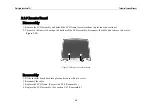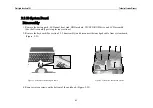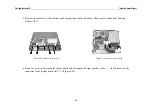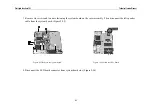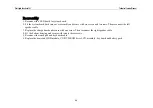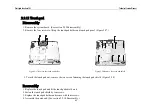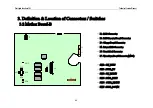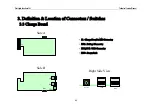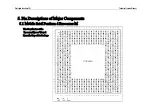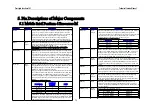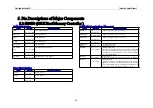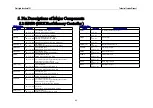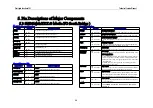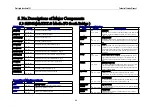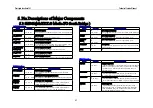
74
Prestigio Cavaliere 141
Technical Service Manual
5. Pin Descriptions of Major Components
Signal Descr iption
Pin Name
Type/No.
Descr iption
A[35:3]#
Input/
Output
A[35:3]# (Address) define a 236-byte physical memory address
space. In subphase 1 of the address phase, these pins transmit the
address of a transaction. In sub-phase 2, these pins transmit
transaction type information. These signals must connect the
appropriate pins of all agents on the Mobile Intel Pentium 4
Processor-M system bus. A[35:3]# are protected by parity signals
AP[1:0]#. A[35:3]# are source synchronous signals and are latched
into the receiving buffers by ADSTB[1:0]#.
On the active-to-inactive transition of RESET#, the processor samples
a subset of the A[35:3]# pins to determine power-on configuration.
A20M#
Input
If A20M# (Address-20 Mask) is asserted, the processor masks
physical address bit 20 (A20#) before looking up a line in any internal
cache and before driving a read/write transaction on the bus.Asserting
A20M# emulates the 8086 processor's address wrap-around at the
1-Mbyte boundary. Assertion of A20M# is only supported in real
mode.
A20M# is an asynchronous signal. However, to ensure recognition of
this signal following an Input/Output write instruction, it must be
valid along with the TRDY# assertion of the corresponding
Input/Output Write bus transaction.
ADS# Input/
Output
ADS# (Address Strobe) is asserted to indicate the validity of the
transaction
ADSTB[1:0]#
Input/
Output
Address strobes are used to latch A[35:3]# and REQ[4:0]# on their
rising and falling edges. Strobes are associated with signals as shown
below.
Signals
Associated Str obe
REQ[4:0]#, A[16:3]#
ADSTB0#
A[35:17]# ADSTB1#
AP[1:0]#
Input/
Output
AP[1:0]# (Address Parity) are driven by the request initiator along
with ADS#, A[35:3]#, and the transaction type on the REQ[4:0]#. A
correct parity signal is high if an even number of covered signals are
low and low if an odd number of covered signals are low. This allows
parity to be high when all the covered signals are high.
AP[1:0]# should connect the appropriate pins of all Mobile Intel
Pentium 4 Processor-M system bus agents. The following table
defines the coverage model of these signals.
Request Signals
subphase 1
subphase 2
A[35:24]# AP0# AP1#
A[23:3]# AP1# AP0#
REQ[4:0]# AP1#
AP0#
Pin Name
Type/No.
Descr iption
BCLK[1:0] Input
The differential pair BCLK (Bus Clock) determines the system
bus frequency. All processor system bus agents must receive
these signals to drive their outputs and latch their inputs.
All external timing parameters are specified with respect to the
rising edge of BCLK0 crossing V
CROSS
.
BINIT#
Input/
Output
BINIT# (Bus Initialization) may be observed and driven by all
processor system bus agents and if used, must connect the appropriate
pins of all such agents. If the BINIT# driver is enabled during
power-on configuration, BINIT# is asserted to signal any bus
condition that prevents reliable future operation.
If BINIT# observation is enabled during power-on configuration, and
BINIT# is sampled asserted, symmetric agents reset their bus LOCK#
activity and bus request arbitration state machines. The bus agents do
not reset their IOQ and transaction tracking state machines upon
observation of BINIT# activation. Once the BINIT# assertion has
been observed, the bus agents will re-arbitrate for the system bus and
attempt completion of their bus queue and IOQ entries.
If BINIT# observation is disabled during power-on configuration, a
central agent may handle an assertion of BINIT# as appropriate to the
error handling architecture of the system.
BNR#
Input/
Output
BNR# (Block Next Request) is used to assert a bus stall by any bus
agent who is unable to accept new bus transactions. During a bus
stall, the current bus owner cannot issue any new transactions.
BPM[5:0]#
Input/
Output
BPM[5:0]# (Breakpoint Monitor) are breakpoint and performance
monitor signals.
They are outputs from the processor which indicate the status of
breakpoints and programmable counters used for monitoring
processor performance. BPM[5:0]# should connect the appropriate
pins of all Mobile Intel Pentium 4 Processor-M system bus agents.
BPM4# provides PRDY# (Probe Ready) functionality for the TAP
port. PRDY# is a processor output used by debug tools to determine
processor debug readiness.
BPM5# provides PREQ# (Probe Request) functionality for the TAP
port. PREQ# is used by debug tools to request debug operation of the
processor.
Please refer to the
Mobile Intel
.
Pentium
.
4 Processor-M and Intel
.
845MP/845MZ Chipset Platform Design Guide
and
ITP700 Debug
Port Design Guide
for more detailed information.
These signals do not have on-die ter mination and must be
ter minated on the system boar d.
5.1 Mobile Intel Pentium 4 Processor-M

